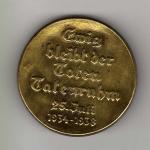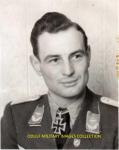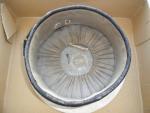-
Posts
2,143 -
Joined
-
Last visited
-
Days Won
10
Content Type
Profiles
Forums
Blogs
Gallery
Events
Store
Everything posted by Odulf
-
The tinny with the text: EWIG/ BLEIBT DER / TOTEN / TATENRUHM / 25. Juli / 1934 – 1938 Shows up from time to time, but (as far as I have found) not many knowledgeable collectors can relate this to an event. The phrase (“Ewig bleibt der Toten Tatenruhm”) is a very well-known and a much recited translation from the Edda (Havamal – Gestaþáttr – Nr.77) “at aldri deyr: dómr um dauðan hvern”. This same phrase was carved in the main beam of the Hans Mallon Haus, near Bergen the main village on the German Baltic island Rügen (Pommerania). A dramatic shot of this memorial for the HJ martyrs from the "Kampfzeit" was used in the opening shots of the propaganda film “Der Masch zum Führer” (recorded in 1938, released in 1940). The date (25 July 1934) relates to the so called “Juliputsch”, when radical Nazis tried to overthrow the Austrian Government under Chancellor Dollfuss. Dollfuss was killed in the action (and nearly decreed “Holy” by his supporters afterwards), but it ended in a mess and the rebels were either shot, or died for other reasons (suicide). It is interesting to note, that obviously the majority of Austrians did not support the radical Nazis at that time. After the Anschluss (13 March 1938), when Austria had voted for incorporation with Germany, and after which date the two became Grossdeutschland, one of the first actions of the NSDAP was to honor the Nazi veterans and victims of their struggle to get a foothold in Austria. Radical and political persons who strived to achieve this ideal needed to be rewarded, as were the Alter-Kämpfer in Germany. On the 25th of July 1938 (four years after the Putsch) a memorial gathering was organized in Vienna, but Hitler was not present, instead he sent his official replacement, Rudolf Hess, as the performer and off course similarities were drawn with the ill-fated November Putsch in Munich (1923). The perished Austrian strivers for a Nazi state were incorporated in the “Hall of Fame” under equal nominations as all others from the Kampfzeit. Thus, the tinny is a commemorative badge to (former) Austrians who were present at this meeting in Vienna.
-
Thanx Morgan!
-
File Name: Bundesmarine Cap Tallies 1955-1990 File Submitter: Odulf File Submitted: 13 Jul 2012 File Category: Germany Introduction This is a copy of a set of photo stats I received from a German fellow collector of cap tallies in the early 1990s. Unfortunately the accompanying correspondence has been lost, so I don’t know if he was the author, but I think that this particular information may be of interest to other collectors of BUNDESMARINE tallies. Because not all users of the GMIC forum can read German, and in particular the used Fraktur script, I have made a crude translation of the most useful information which the author, Mr. Kurt Speckmann, has added. Many Bundesmarine tallies are sold on the market as dating from the period between 1929 and 1939, therefore chapter 1 of the lists can be of use to collectors of Kriegsmarine also. As the list has been corrected until about 1991, all later introduced Bundesmarine tallies are not included. Sincerely, Odulf Preface to the 1st edition. In both the Kaiserliche Marine [1871-1919] and the Reichsmarine [1919-1935] the cap tallies showed Latin printing type script. From 1927 the Union For German Script repeatedly suggested to the Admiralty to use German script for naval cap tallies, successfully after all. On 14 October 1929 the Admiralty announced that hence forward for new ships ship’s names, cap tallies and lettering should be executed in fat Imperial Gothic [“Fraktur”] script. Thus, collectors should not use the term “Gothic” tallies, but “Fraktur” tallies instead. The first ship to receive the new type tally was the Kreuzer Karlsruhe [in November 1929]. The script on this tally was 15 mm high, but this was found to be to narrow an it was altered to 20 mm. Later all other older ships received the new style tallies. Also the Bundesmarine [from 1955] continued the Fraktur type text on the cap tallies. Unfortunately the general knowledge of the correct use of the Fractur type was not so common as before 1945. The problems were connected to the use of the “long s” [which resembled very much the letter “l” and the “rounded s”. Thus variations of the same ship’s name appeared in different writing. In the following outline of Bundesmarine cap tallies I have included all known variations. The Fractur script was removed from the cap tallies in 1959, to be replaced by the Latin script (Beton-antiqua). I would be interested to learn the plausible reason for this. The Netherlands and DDR stuck to the Fractur script, and I hope that the USSR and other nations will never let go of their national script. On 16 October 1959 the General Inspector of the Bundesmarine agreed to the manufacturing of the new cap tallies, and the old style cap tallies were allowed to be worn until 1 October 1960, and from that day on only the new style. Because it cannot be exactly determined for individual tallies when they were replaced, I have placed the date ending the wearing of Fractur script tallies on December 1959. Thus the beginning of the new (Latin) script in Breton-antiqua begins in January 1960. The tallies which were ordered via the Beschaffungsamt [Purchasing-Department] in Koblenz, are always executed in Viscose fibre (Reyon gelb) [yellow rayon]. Thus: all names woven in metal wire (gold) are so-called Canteen tallies, Officers tallies or Bluff tallies. TO CHAPTER 1 In the 1st chapter of the next outlines, the tallies from the period between 1955 and 1959 are listed. All tallies listed are in Fraktur script, inclusive the variations. TO CHAPTER 2 In the 2nd chapter, all official post 1960 tallies are listed. The script used is Breton-Antiqua, in yellow rayon. All these were ordered by the Purchasing-Department in Koblenz, and as such these are all official. TO CHAPTER 3 In the 3rd chapter all unofficial are listed, these were not to be worn on duty. These are called: Kantinenbänder [Canteen tallies] Offiziersbänder [Officers tallies] Renommierbänder [bluff/Boast tallies] Tallies listed were not all observed, there fore it is possible that they were not woven, but part of these realy do exist. It must be stressed that always tallies, so far unknown, may appear. Click here to download this file
-
The lapel badge left, is the Arbeits Dank pin of the Reichsarbeitsdienst and the badge right is the Petsamo-Rovaniemi. The RAD Gruppen K363 and K376 from Austria and Sudeten Germany were ordered to North Finland (Lappland) as Pioneer troops (Bautruppen) for the German 3rd Gebirgsdivision. It took them 13 months to build a road of 25 km, from 21 June 1941 until 30 June 1942.
-

Nooooooooo .......... !
Odulf replied to Robin Lumsden's topic in Great Britain: Militaria: Badges, Uniforms & Equipment
Obviously, this is another proof of politicians unaware of their Nation's military history. In accordance with the suggestion of Chris, the so called "Cardwell Reforms" of the 1870s springs to mind, but perhaps the cost (purse reigns over history) will be a problem (what's new). Also, Armies (and Navies as well as Air Forces) are a tool of politics, and to keep traditions in a world of change for the sake of traditions is no option. Old soldiers never die, but their memory is bound to fade away, unless for the old-comrades societies, historical interested, and collectors. Collectors and military historians are the custodians of history, not politicians! -

Heer Pioniere
Odulf replied to Odulf's topic in Germany: Third Reich: Uniforms, Headwear, Insignia & Equipment
Thanks for sharing your thoughts. I do not support the thought that the cap was borrowed, because these men are wearing the walking-out uniform which was always accompanied by the vizor cap, and these are photo studio portraits. They would not have been allowed out of barracks without a uniform check. -
Thanks Robin, interesting to note that the wheel is composed of 9 wheat heads, as the number 9 in Nordic religion was considered holy (a little bit pagan...)
-
What I was relating to, is that in the late 1930s and early 1940s cotton/rayon replaced in some cases the goldwire, but you can find more information on this forum: http://gmic.co.uk/index.php/topic/50851-hms-tallies-how-to-tell-the-difference/page__st__20 To my opinoon the hat is 1940s, but I have doubts about the age of the tally.
-
When I see it right, the letters are in yellow rayon, not in gold wire. This could indicate late 1930s, but this style was used until about the 1970s. After the war tallies with old ship's names were also produced for souvenirs. The type of sailor's hat is 1940s (see enclosed photo of a hat from the early 1940s)
-
Can you take off the tally and show us the reverse, that may provide information about the age? The bow is very untidy, a disgrace for any sailor. The tally is twisted round the hat, the airing holes should be over the ears (thus due starboard and portside of the skull) and the ship's name positioned exactly at the front. It is unlikely that the Navy reintroduced the tally after the war, for the ship was placed on the reserve list early 1945, to be decommissioned and scrapped. Enclosed a photo of a nicely tied bow in wear.
-
I agree with the remark of dmiller8 : "..., but the article got it incorrect in stating that it is the highest Papal knighthood that can be awarded, when there are three others higher in precedence such as the Order of Christ, the Golden Spur and the Order of Pius IX" I suppose this is beacause reporters rely on a quick glance on the internet, and thus missing out on the merit or service for which a Papal Order was awarded. Generally, the Order of Christ is reserved for RC Heads of State (kings and princes); the Golden Spur for non-catholic Heads of State; the Order of Pius for Heads of State and diplomats visiting the Pope - thus also to many ambassadors to the Holy See. The remaining Orders - Order of St.Gregory the Great and Order of St.Sylvester are awards for persons who respective were meritious to the Holy Church and persons who were meritious to both Church and (general) society. Of course, the Knight Grand Cross is the highest grade within the Order. These differences are (obviously) nearly to complex for journalists...
-
Do I read? GOTTES SEGEN HUS HIMMEL UND ERDE







